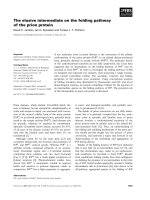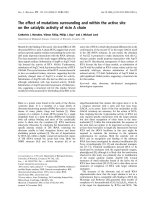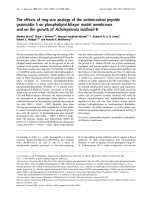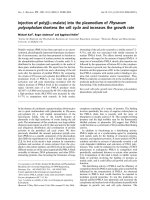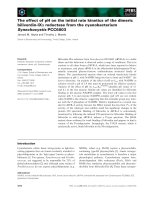ON THE GROWTH RATE OF GENERALIZED FIBONACCI NUMBERS DONNIELL E. FISHKIND Received 1 May 2004 Let ppt
Bạn đang xem bản rút gọn của tài liệu. Xem và tải ngay bản đầy đủ của tài liệu tại đây (477.11 KB, 5 trang )
ON THE GROWTH RATE OF GENERALIZED
FIBONACCI NUMBERS
DONNIELL E. FISHKIND
Received 1 May 2004
Let α(t) be the limiting ratio of the generalized Fibonacci numbers produced by sum-
ming along lines of slope t through the natural arrayal of Pascal’s triangle. We prove that
α(t)
√
3+t
is an even function.
1. Overview
Pascal’s triangle may be arranged in the Euclidean plane by associating the binomial co-
efficient
i
j
with the point
j −
1
2
i,−
√
3
2
i
∈ R
2
(1.1)
for all nonnegative integers i, j such that j ≤ i, as illustrated in Figure 1.1. The points in
R
2
associated with
i
j
,
i+1
j
,and
i+1
j+1
form a unit equilateral triangle. This arrayal is
called the natural arrayal of Pascal’s triangle in R
2
.
For all t ∈ R : −
√
3 <t<
√
3 and nonnegative inte gers k,defineᏸ
k
(t)tobethesum
of all binomial coefficients associated with points in R
2
which are on the line of slope
t through the point in R
2
associated with
k
0
. It is well known that {ᏸ
k
(
√
3/3)}
∞
k=0
is
the Fibonacci sequence F
0
,F
1
,F
2
, ,and{ᏸ
k
(−
√
3/3)}
∞
k=0
is the sequence of every other
Fibonacci number F
0
,F
2
,F
4
, , as illustr ated in Figure 1.1;forafixedt, the sequence
{ᏸ
k
(t)}
∞
k=0
is called the generalized Fibonacci sequence induced by the slope t. Generalized
Fibonacci numbers arise in many ways; for example, for any integers a, b :1≤b ≤ a,the
number of ways to distribute a identical objects to any number of distinct recipients such
that each recipient receives at least b objects is
∞
l=1
l −1+a −l ·b
l −1
=
ᏸ
a−b
b −1
b +1
√
3
. (1.2)
Copyright © 2004 Hindawi Publishing Corporation
Advances in Difference Equations 2004:4 (2004) 273–277
2000 Mathematics Subject Classification: 39A11, 11B39, 11B65
URL: />274 Growth rate of generalized Fibonacci numbers
y
x
0
0
1
1
1
0
2
0
2
1
2
2
3
0
3
1
3
2
3
3
4
0
4
1
4
2
4
3
4
4
5
0
5
1
5
2
5
3
5
4
5
5
ᏸ
2
√
3
3
= 2
ᏸ
3
√
3
3
= 3
ᏸ
4
√
3
3
= 5
ᏸ
5
√
3
3
= 8
0
0
1
0
1
1
2
0
2
1
2
2
3
0
3
1
3
2
3
3
4
0
4
1
4
2
4
3
4
4
5
0
5
1
5
2
5
3
5
4
5
5
6
6
ᏸ
0
−
√
3
3
= 1
ᏸ
1
−
√
3
3
= 2
ᏸ
2
−
√
3
3
= 5
ᏸ
3
−
√
3
3
= 13
Figure 1.1. The natural arrayal of Pascal’s triangle and Fibonacci numbers as line sums.
For all t ∈R : −
√
3 <t<
√
3, we define α(t) to be the limiting ratio of the generalized
Fibonacci sequence induced by the slope t; that is, α(t):= lim
k→∞
ᏸ
k+1
(t)/ᏸ
k
(t). The
following is our main result.
Theorem 1.1. For all t ∈R : −
√
3 <t<
√
3,itholdsthatα(t)
√
3+t
=α(−t)
√
3−t
.
(Theorem 1.1 is easily and directly verified when t =±
√
3/3, since the rate of growth
of the sequence of every other Fibonacci number is the square of the rate of growth of the
Fibonacci sequence.)
Generalized Fibonacci numbers arising as line sums through Pascal’s triangle were
introduced by Dickinson [2], Harris and Styles [4], and Hochster [6], and have been
presented extensively in the literature (see [1, 5, 7]). The classical setting has been the
left-justified arrayal of Pascal’s triangle, which we define in Section 2. In the setting of
the left-justified arrayal, Harris and Styles (and, effectively, Dickinson) show that gener-
alized Fibonacci numbers satisfy the difference equation (2.5)inSection 2, and thus have
rate of growth as given in (2.6)ofSection 2.Ferguson[3] investigated the roots of the
polynomial in (2.6)whenq is an integer.
Our contribution is to investigate this rate of growth as a function of the generating
slope, to transfer the setting to the natural arrayal of Pascal’s triangle, and, in Section 3,
to prove Theorem 1.1.InSection 2, we review classical facts and correlate them to the
natural arrayal of Pascal’s triangle.
2. The Left-Justified Arrayal
It is sometimes easier to consider the left-justified arrayal of Pascal’s triangle in
R
2
,in
which the binomial coefficient
i
j
is associated with the point (j, −i) ∈ R
2
for all non-
negative integers i, j : j ≤ i, as illustrated in Figure 2.1.
Consider any q = n/d > −1suchthatn and d are relatively prime integers and d is
positive. For all nonnegative integers k,defineL
k
(q)tobethesumofallbinomialcoeffi-
cients associated with points in R
2
on the line y = qx−(1/d)k [this choice of y-intercept
is such that every binomial coefficient
i
j
is included in such a sum for some k]. Now,
define β(q):= lim
k→∞
L
k+1
(q)/L
k
(q) and also define γ(q):=lim
k→∞
L
(k+1)d
(q)/L
kd
(q); we
Donniell E. Fishkind 275
y
x
0
0
1
0
1
1
2
0
2
1
2
2
3
0
3
1
3
2
3
3
Figure 2.1. The left-justified arrayal of Pascal’s triangle.
see from taking the limit of L
(k+1)d
(q)/L
kd
(q) =
d−1
l=0
L
kd+l+1
(q)/L
kd+l
(q)ask →∞that
γ(q) =
β(q)
d
. (2.1)
Lines of slope q =n/d in our left-justified arrayal correspond to lines of slope
(
√
3/2)n
(1/2)n + d
=
√
3q
q +2
(2.2)
in the natural arrayal, and
k
0
is a summand of L
kd
(q) and thus, for all nonnegative
integers k, L
kd
(q) =ᏸ
k
(
√
3q/(q + 2)). Hence,
γ(q) =α
√
3q
q +2
. (2.3)
Defining t :=
√
3q/( q + 2) (note that −
√
3 <t<
√
3), we write q as a function of t,obtain-
ing, by (2.3),
α(t)
= γ
2t
√
3 −t
. (2.4)
For the moment, suppose that q is positive. Using the identit y
i
j
+
i
j+1
=
i+1
j+1
,
there is a correspondence (see Endnote(I)) between the binomial coefficients summed
in L
k
(q), those summed in L
n+k
(q), and those summed in L
n+d+k
(q) yielding the linear
difference equation
L
n+d+k
(q) −L
n+k
(q) −L
k
(q) =0fork =0,1,2, (2.5)
It is not hard to verify that the associated auxiliary polynomial x
n+d
−x
n
−1 has distinct
roots, say λ
1
,λ
2
, ,λ
n+d
, and the initial conditions ensure nonzero constants c
1
,c
2
, ,
c
n+d
∈ R in the expansion L
k
(q) =
n+d
l=1
c
l
λ
k
l
, k = 0,1,2, (these constants c
l
are given
explicitly in [2]). Among these roots, λ
1
,λ
2
, ,λ
n+d
, there is a unique positive root, and
this root is also the root of maximum modulus (see Endnote(II)). Thus, β(q)istheunique
positive root of x
n+d
−x
n
−1 and, substituting (2.1) into this,
γ(q) is the unique positive root of x
q+1
−x
q
−1. (2.6)
276 Growth rate of generalized Fibonacci numbers
If, instead, −1 <q≤ 0 (i.e., d>−n ≥0), then similar analysis yields the linear differ-
ence equation
L
d+k
(q) −L
−n+k
(q) −L
k
(q) =0fork =0,1,2, , (2.7)
and β(q) is the unique positive root of the auxiliary polynomial x
d
−x
−n
−1. Multiplying
the equation x
d
−x
−n
−1 = 0byx
n
yields that β(q) is the unique positive root of the (now
nonpolynomial) x
n+d
−x
n
−1 and thus, by (2.1), statement (2.6 ) holds for nonpositive
q’s as well.
3. Proof of Theorem 1.1
Let
√
3Q
(−1,1)
denote the set {t ∈ (−
√
3,
√
3) : t/
√
3isrational},where(−
√
3,
√
3) is the
open interval of real numbers from −
√
3to
√
3.
Proposition 3.1. The function α(t) is continuous on the set
√
3Q
(−1,1)
.Thefunctionα(t)
is identically 1 on the set (−
√
3,
√
3)\
√
3Q
(−1,1)
.
Proof. As noted before, the slope t ∈(−
√
3,
√
3) in the natural arrayal corresponds to the
slope q
= 2t/(
√
3 −t) > −1 in the left-justified arrayal, and such q is rational if and only
if t/
√
3isrational.Ifsuchq is not rational, {ᏸ
k
(t)}
∞
k=0
is just the sequence
k
0
∞
k=0
,and
α(t) =1.
On the other hand, for q ∈ Q : q>−1, (2.6) may be solved to yield that q =
−ln(γ(q) −1)/ln(γ(q)); the continuity of the inverse function of γ implies the continuity
of γ.By(2.4)andfort such that q = 2t/(
√
3 −t)isrational,α is the composition of γ and
another continuous function, thus α is continuous on
√
3Q
(−1,1)
.
Lemma 3.2. For any rational number q>−1, γ(q)
q+1
= γ(−q/(q +1)).
Proof. Suppose q = n/d > −1suchthatn and d are relatively prime integers and d is
positive. Note that −n/(n + d) > −1 and observe that β(n/d)andβ(−n/(n + d)) are each
the unique positive root of x
n+d
−x
n
−1, which is also the unique positive root of x
d
−
x
−n
−1andso,inparticular,
β
n
d
=
β
−n
n + d
. (3.1)
Thus, by (2.1)and(3.1), we have
γ
n
d
n+d
= β
n
d
d(n+d)
= β
−n
n + d
d(n+d)
= γ
−n
n + d
d
. (3.2)
Taking the dth root of (3.2) and simplifying yields the desired result.
We next prove our main result, Theorem 1.1, which states that for all t ∈R such that
−
√
3 <t<
√
3wehaveα(t)
√
3+t
= α(−t)
√
3−t
.
Donniell E. Fishkind 277
Proof of Theorem 1.1. For all t ∈
√
3Q
(−1,1)
,wehave,byProposition 3.1, α(t) = 1, in
which case the result is trivial. For all t ∈
√
3Q
(−1,1)
,wehavethat2t/(
√
3 −t)isratio-
nal and greater than −1. Thus,
α(t)
√
3+t
= γ
2t
√
3 −t
√
3+t
by (2.4)
=
γ
2t
√
3 −t
2t/(
√
3−t)+1
√
3−t
= γ
−
2t/(
√
3 −t)
2t/(
√
3 −t)+1
√
3−t
(by Lemma 3.2)
= γ
2(−t)
√
3 −(−t)
√
3−t
= α(−t)
√
3−t
by (2.4)
.
(3.3)
Endnotes. (I) Since consecutive line sums in the sequence of line sums differ in y-inter-
cept by 1/d, the line sum including
i
j+1
and the line sum including
i+1
j+1
, which have
y-intercepts that differ by 1, must be d line sums apart. Symmetric reasoning dictates that
the line sum including
i
j
and the line sum including
i
j+1
are n line sums apart in the
sequence of line sums.
(II) To sketch some details, the nonzero roots of (d/dx)(x
n+d
−x
n
−1) are the dth roots
of n/(n + d), exactly one of which is positive and none of which are roots of x
n+d
−x
n
−1,
hence the roots of x
n+d
−x
n
−1 are distinct and (considering a few basic features of this
polynomial on the positive real line) exactly one is positive, call it λ.If
˜
λ is any other root
of x
n+d
−x
n
−1 besides λ,then1=|
˜
λ
n+d
−
˜
λ
n
|≥|
˜
λ|
n+d
−|
˜
λ|
n
and, because equality does
not hold in this triangle inequality, we have |
˜
λ|
n+d
−|
˜
λ|
n
−1 < 0, implying |
˜
λ| <λ.
References
[1] M. Bicknell, A primer for the Fibonacci numbers: part VIII,FibonacciQuart.9 (1971), 74–81.
[2] D. Dickinson, On sums involving binomial coefficients, Amer. Math. Monthly 57 (1950), 82–86.
[3] H.R.P.Ferguson,On a generalization of the Fibonacci numbers useful in memory allocation
schema; or all about the zeroes of Z
k
−Z
k−1
−1, k>0, Fibonacci Quart. 14 (1976), no. 3,
233–243.
[4] V. C. Harris and C. C. Styles, A generalization of Fibonacci numbers,FibonacciQuart.2 (1964),
277–289.
[5]
, Generalized Fibonacci sequences associated with a generalized Pascal triangle,Fibonacci
Quart. 4 (1966), 241–248.
[6] M. Hochster, Fibonacci-type series and Pascal’s triangle,Particle4 (1962), 14–28.
[7] V.E.HoggattJr.,A new angle on Pascal’s triangle,FibonacciQuart.6 (1968), no. 4, 221–234.
Donniell E. Fishkind: Department of Applied Mathematics and Statistics, The Johns Hopkins Uni-
versity, Baltimore, MD 21218-2682, USA
E-mail address: fi




